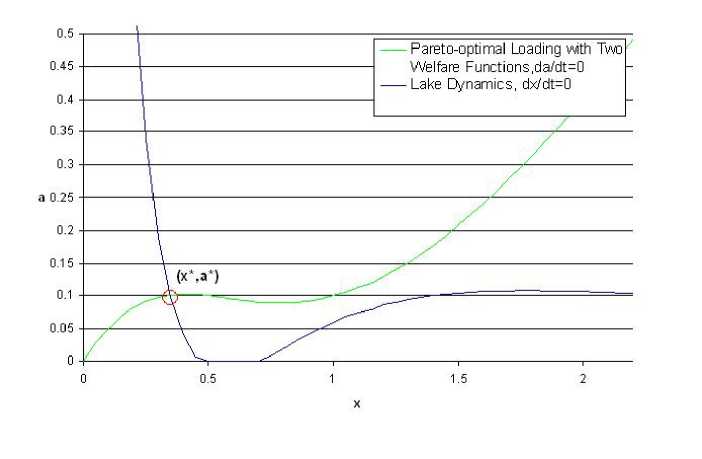which means a* = 0 or:
<i(t) =
--------x(t) (eɪnɪ + С2П2) -
n1 + n2
b+ρ-
2x(t)
(x2(t) + 1)2
=0
And so the steady-state Pareto-optimal solution is:
(nɪ + n2) b + ρ - 25)
*
a*
(x2(t)+1)
(19)
2x(t) (eɪnɪ + n2c2)
3.2 Graph and Analysis of the Steady-state Dynamic Pareto-
optimal Solution
This solution can be plotted in the (x,a)-plane together with the phase plot for
the steady-states of the lake when dx/dt = 0, given by equation (3). The inter-
section of the two curves gives society’s optimal phosphorous loading solution.
Using the hysteretic lake value b = 0.6, ρ = 0.03, nɪ = 2, n2 = 2, c1 = 0.2 and
c2 = 2, the graphs intersect at (x*, a*) = (0.3472, 0.1007), as shown in Figure 1
below, thus giving us the Pareto-optimal steady-state equilibrium. Note that
this result is below the point at which the lake flips from an oligotrophic to a
eutrophic state, i.e. for the selected constants, society prefers an oligotrophic
lake.

Figure 1: Pareto-optimal Loading with Two Welfare Functions
10
More intriguing information
1. The name is absent2. DURABLE CONSUMPTION AS A STATUS GOOD: A STUDY OF NEOCLASSICAL CASES
3. Philosophical Perspectives on Trustworthiness and Open-mindedness as Professional Virtues for the Practice of Nursing: Implications for he Moral Education of Nurses
4. A COMPARATIVE STUDY OF ALTERNATIVE ECONOMETRIC PACKAGES: AN APPLICATION TO ITALIAN DEPOSIT INTEREST RATES
5. Regional science policy and the growth of knowledge megacentres in bioscience clusters
6. The Role of Immigration in Sustaining the Social Security System: A Political Economy Approach
7. Reputations, Market Structure, and the Choice of Quality Assurance Systems in the Food Industry
8. APPLYING BIOSOLIDS: ISSUES FOR VIRGINIA AGRICULTURE
9. BEN CHOI & YANBING CHEN
10. Are class size differences related to pupils’ educational progress and classroom processes? Findings from the Institute of Education Class Size Study of children aged 5-7 Years